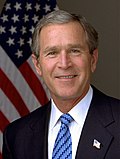| ||
|---|---|---|
Business and personal
46th Governor of Texas 43rd President of the United States
Tenure Appointments Presidential campaigns  | ||
The following is a timeline of the presidency of George W. Bush from his inauguration as the 43rd president of the United States on January 20, 2001, to December 31, 2001.







